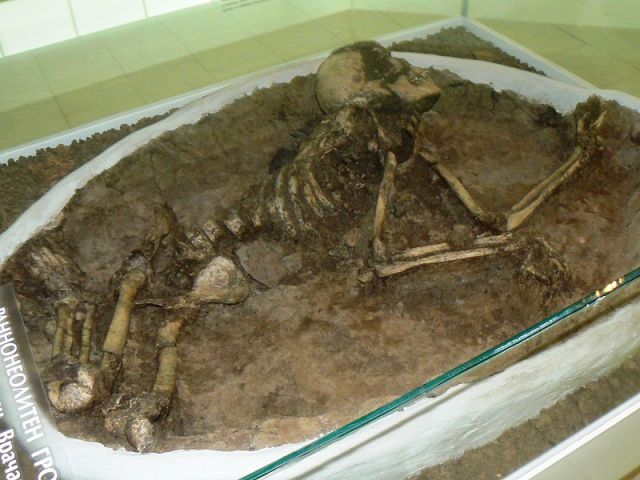Flooding Threatens Unique Early Neolithic Settlement in Ohoden in Northwest Bulgaria

This photo shows lead archaeologist Georgi Ganetsovski during excavations at the Early Neolithic settlement in Ohoden back in 2012. Photo by Bulgarian National Radio Vidin
The archaeological excavation site of the unique Early Neolithic settlement near the town of Ohoden in Northwest Bulgaria, which is seen as representing what might be Europe’s earliest civilization, is under threat of being flooded by the Skat River.
The archaeological excavations at Ohoden are at risk because of the melting snow and the clogged bed of the Skat River, Ohoden Mayor Ivan Ivanov has alarmed, as cited by local news site Tribali.
Ivanov has called for urgent actions on part of the local authorities for the cleaning of the river bed and clearing the area around the 8,000-year-old settlement because the accumulation of fallen trees, bushes, and river deposits may direct the rising waters towards the excavation site.
The Early Neolithic settlement near Ohoden has been excavated since 2002 by a team of Bulgarian archaeologists from the Vratsa Regional Museum of History led by archaeologist Georgi Ganetsovski.
It is unique for what appear to be (some of) the earliest traces of civilized human life in Europe, including a fertility and son temple (i.e. of the sun cult), and belongs to the so called Gradeshnitsa-Karcha Early Neolithic Culture which developed on both sides of the Lower Danube in today’s Northwestern Bulgaria and Southwestern Romania.

The 8,000-year-old grave of a woman dubbed “Todorka” from the Early Neolithic settlement in Bulgaria’s Ohoden, as exhibited in the Vratsa Regional Museum of History. Photo by Vassia Atanassova – Spiritia, Wikipedia
Background Infonotes:
The Early Neolithic settlement near the town of Ohoden, Vratsa Municipality, in Northwest Bulgaria is one of the earliest human settlements in Europe dating back to the 6th millennium BC. It consists of prehistoric homes, a necropolis, and a fertility and sun temple. It features what might be the earliest known sun temple which is about 8,000 years old, as are the prehistoric human skeletons found there. The analysis of the artifacts found at the Ohoden Early Neolithic settlement shows that it belongs to the so called Gradeshnitsa-Karcha Early Neolithic Culture which developed in today’s Northwestern Bulgaria and Southwestern Romania. The finds from the Ohoden excavations indicate that the Balkan Peninsula was the center of a prehistoric civilization that spread to the rest of Europe.
Back in 2011, the archaeologists excavating Ohoden discovered a sanctuary with a prehistoric altar decorated with huge trophy elk horns placed 2 meters away from the ritual burial of a man discovered in 2010. The scholars have stipulated that the altar was used to glorify the buried man’s hunting achievements. The sanctuary is believed to have been a fertility and son temple as its floor was paved with U-shaped stones directed to the east; it contained dozens of clay and stone disc symbolizing the sun disc, respectively the sun cult, in early agrarian societies. These finds that are unique of their kind in the entire world have led the scholars to hypothesize that it might be the world’s oldest temple dedicated to the sun.
The first grave excavated at Ohoden was found in 2004. It belonged to a woman who was named with the Bulgarian female name “Todorka” by the local archaeologists. Todorka’s burial is exhibited in the Vratsa Regional Museum of History. Three more Early Neolithic graves have been discovered at Ohoden.The Early Neolithic homes whose remains were discovered at Ohoden showed traces of beams and columns 45 cm in diameter which is evidence of massive walls and roofs. The 8,000-year-old Early Neolithic settlement in Ohoden in Northwest Bulgaria was first found in 2002. It has been excavated by a team of archaeologists from the Vratsa Regional Museum of History led by archaeologist Georgi Ganetsovski.









